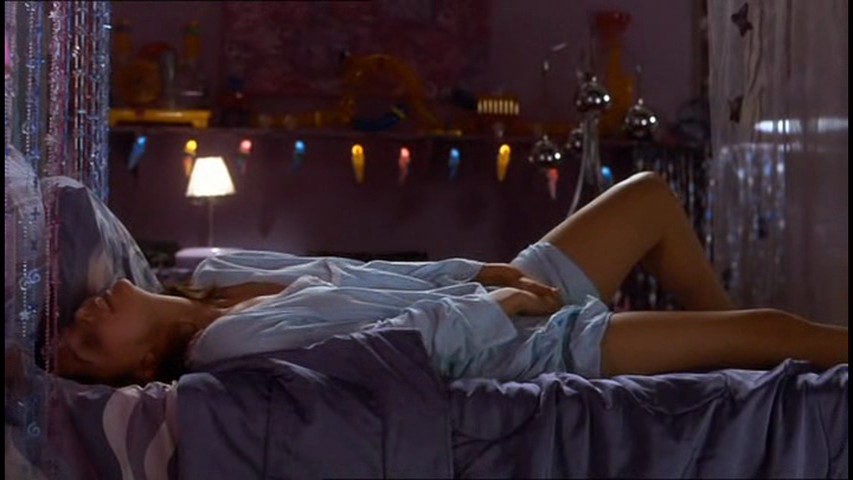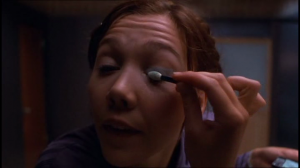
This guest post by Toni McIntyre appears as part of our theme week on Dystopias.
At first glimpse, I’ll admit that Sucker Punch looks like little more than Zach Snyder’s latent schoolgirl fantasies brought to life. That Emily Browning, who plays main character Babydoll, has: A) that patronizing name and B) the dewy wide eyes of an anime heroine don’t exactly help. That said I’ve never been one to dismiss a film on wardrobe choices alone, even if they do cater a whole buffet’s worth to the male gaze. Snyder himself has even hinted that the aesthetics of Sucker Punch were chosen deliberately to mock geek culture’s sexualized fantasy version of women. Whether he was successful in that endeavor or not is fodder for another essay. The point is that as waifish as Babydoll appears, and however we may be tempted to dismiss Sucker Punch as just another male fantasy, a close look at the dystopian spaces within the film and how Babydoll exists in those spaces reveals a more woman-friendly, if bittersweet, reading.
The tragedy that starts the movie in earnest takes place in a very tight space. Babydoll attempts to shoot her abusive stepfather as he breaks down the door to a closet where Babydoll’s sister is hiding. The shot misses its intended target, ricochets in a way only bullets in movies can, and fatally wounds Babydoll’s sister inside the closet. Taking immediate advantage of the situation to unburden himself of his remaining stepdaughter, Babydoll’s stepfather carts her off to a mental hospital. Babydoll trades one menacing patriarchal force for another as crooked orderlies loom menacingly over Babydoll and the other broken but beautiful patients.

Unable to cope with the reality of being in the hospital, Babydoll escapes inward and creates the first of two imagined worlds in her own mind. The first space is a richly adorned bordello and exists as the real world askew. The women from the hospital are still trapped, to a degree, in the bordello, but they have noticeably more power in how they present themselves to each other and to their male customers than they do in the hospital. It’s enough for Babydoll to become much more vocal once she’s imagined to be in the bordello—she becomes a plotting, rallying force for the other women.
It’s Babydoll’s second imagined world, one she accesses while she dances and enters a trance-like fugue state within the bordello, that Babydoll acts out her readiness to fight. While in the bordello everything is secrets and plans, in this second world, it’s all action. This second space is where things expand, where we get wide shots of extravagant landscapes—feudal Japan, a dragon’s den, a maze of soldier’s trenches. This second world is the tiny space of the closet where Babydoll fought her first battle, and where she lost in every sense of the word, blown wide open, given the space Babydoll needs in order to imagine battles she can fight and win.

Famed author and neurologist Oliver Sacks was observing a patient who experienced “transports” similar to Babydoll’s. Sacks pitied his patient and described the man’s imagined worlds as a “deceiving surface of illusion” that lacked anything deep or true. I’m not going to say Oliver Sacks is wrong in his observation, but I think it’s a simple way of looking at mental worlds or spaces—as untrue. I don’t think we’re meant to view any of the worlds Babydoll creates as false. And to quote another very wise and bearded man, Albus Dumbledore, even if something is happening only in your head, “Why on earth should that mean it’s not real?”
Babydoll had to travel within herself to worlds she created and could control, in order to discover a truth. We get a glimpse of what that truth is in a bit of dialogue delivered by the older matriarch figure the bordello:
“You see, your fight for survival starts right now. You don’t want to be judged? You won’t be. You don’t think you’re strong enough? You are. You’re afraid. Don’t be. You have all the weapons you need. Now fight.”
By creating her own worlds where she is a force to be reckoned with, Babydoll reclaims that very thing that was taken away from her by her stepfather and the hospital: her humanity.
Sucker Punch strives for optimism. The film wants to tell us that we have all the power within ourselves to rally against an unjust system. For a film bleeding special effects, it hits a real gut-punch worthy note of reality when we watch Babydoll fight—and fail. Again. The patriarchal forces at the hospital resurface and Babydoll sacrifices herself to ensure the escape of one of her fellow patients. Babydoll is lobotomized, her physical being trapped in the hospital, her mind free to sink down within the worlds she made for herself. Sucker Punch wants to tell us we have all the power we need to fight a unjust system, but, also, that that system sometimes still wins. It’s honest and brutal. Babydoll is made a prisoner twice over, and it’s a cold comfort that at least the second time, the decision to become locked in her own mind is hers. Sucker Punch is a story of finding your strength. It’s about looking in when those in control take away your ability to look out. It’s about making your own space when the space they give you is too small and too controlled for you to actually be. It’s equal parts a suggestion and a warning of what happens when you travel far enough into your own subconscious to really know yourself and all you’re capable of when the world outside may still beat you down. When I think about Babydoll, locked in her own mind, I think about when Gatson Bachelard warned that “he who buries a treasure, buries himself with it.”
Toni McIntyre is a native of Philadelphia but a Pittsburgh hockey fan. She once wrote a paper in grad school on Inception and couldn’t sleep for a week. She’s very often, too often, on Twitter.







